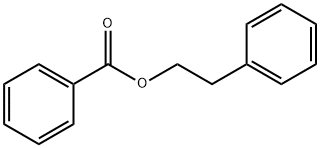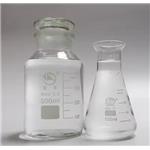Phenethyl benzoate has a sweet, rose and honey-like odor. It is used in trace quantities for fixation of honey, strawberry
and other fruit preserves.
Reported found in the essential oil from flowers of rose and orange, in bilberry, cinnamon leaf, cassia leaf,
malay apple and sea buckthorn.
Phenethyl Benzoate is a building block used in the synthetic preparation of esters using Bi(OTf)3 catalyzed acylation of alcohols with acid anhydrides.
From phenethyl alcohol and benzoyl chloride in the presence of NaOH; from phenylethyl alcohol and methylbenzoate; by
esterification of phenylethyl acohol with benzoic acid.
ChEBI: Phenethyl benzoate is a benzoate ester resulting from the formal condensation of the carboxy group of benzoic acid with the hydroxy group of 2-phenylethanol. It has a role as a plant metabolite and a volatile oil component. It is functionally related to a benzoic acid and a 2-phenylethanol.
Phenylethyl Benzoate is used in Carnation, Neroli, Rose and Oriental bases mostly as a fixative and a blender/modifier in the heavier portion of the fragrance. It is a good base for Peony and other delicate florals and blends well with most of the conventional “middle notes”. This material is also used in flavour compositions in minute traces for fixation of Honey, Strawberry and various fruit types. The concentration is normally as low as 1 to 4 ppm in the finished product.
Flammability and Explosibility
Not classified
The metabolism of benzoic acid has been extensively studied in more than 20 species, including man (Williams, 1959). Depending on species and other factors, such as availability of glycine, benzoic acid may be excreted in the urine as hippuric acid, benzoyl glucuronide or other compounds (see, for example, Bridges. French. Smith & Williams, 1970; Irjala, 1972; Kato, 1972; Martin, 1966; Runyan, 1971; Strahl & Barr, 1971; Wan & Riegelman, 1972). The major route of biotransformation of benzoic acid in man is conjugation with glycine to form hippuric acid, the rate-limiting factor in this reaction being the availability of glycine (Amsel & Levy. 1969). In man at a dose of 1 mg/kg, benzoic acid is excreted entirely as hippuric acid (Bridges et al. 1970). Phenylethyl alcohol is oxidized almost entirely to phenylacetic acid (Williams, 1959). In rabbits, a small amount of benzoic acid is also formed; the phenylacetic acid is excreted mainly as phenace�turic acid (Smith, Smithies & Williams, 1954).


